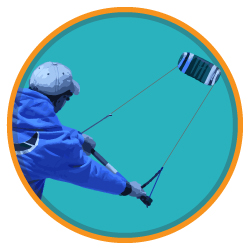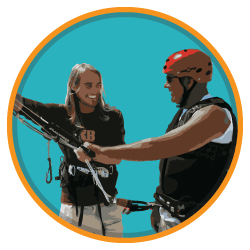How To Get into Kiteboarding
There are a few basic steps for entrance into the awesome sport of kiteboarding, essentially starting with learning on a trainer kite, taking a lesson, and then getting the gear.
What is Kiteboarding?
Kiteboarding is one of the most exciting outdoor water/wind sports a person can get involved in. There isn't a feeling like it! Kiteboarding can be related to a combination of wakeboarding, surfing, snowboarding, and of course includes kiteflying. Kiteboarding is similar to wakeboarding, but with the freedom of being tethered to a boat.
Spending time learning to fly a trainer kite is an essential step in learning to Kiteboard. Trainer kites, sometimes referred to as trainers for short, are typically a two-line foil kite from 1.2m-3m in size and come with a bar used for steering. Flying a trainer is where you learn the basics of kite control and power zones in the wind window. The more proficient you are at flying a trainer the quicker you'll pick up skills with a larger kite in a lesson with a qualified instructor.
A good standard for proficiency is if you can carry on a conversation with a friend, or close your eyes and maintain kite control flying "blindly" you'll be able to cut down on frustration and extra money spent on lessons.
Kiteboarding is not a sport you learn on your own. Your instructor will not only teach you skills for becoming a successful kiteboarder, but will also teach you how to be a safe kiteboarder.
The importance of taking a lesson cannot be overemphasized. Kiteboarding is a blast, but without proper instruction it can be extremely dangerous for you and others. Please get a lesson! We feel very strongly about this as your safe entry to the sport really matters to us!
At kiteboarding.com we feel so strongly about the importance of lessons we offer opportunities for free lessons: Free Lesson Details
Look for lessons offered through a professional established shop with instructors who are PASA (Professional Air Sports Association) certified. Selecting a certified instructor from a reputable shop will give you assurance that you're getting the most current information on safety, set up, flying, kite control, and the equipment being used for instruction is well kept, regularly inspected, and up to date.
During your lesson you can expect to learn:
- Basic Kite flying skills
- Common safety features of kites
- Site selection tips (what to look for and what to stay away from)
- Weather patterns and Wind awareness
- Board skills
When it comes to getting the right gear whether you are new to the sport or have had some experience, it's always a good idea to get some input from professionals. Year to year advancements are made to kite design, board construction and harness structure. By consulting with a local kite shop before you make a purchase, you are obtaining the latest information on gear. When you consult with kiteboarding.com, you are also receiving our first hand tested experience. You'll find we don't sell every brand of kite, board, and harness, and there is a reason for it. Every product listed on our site and stocked on the shelves has been tested by a kiteboarding.com employee. When new products come our way, we try them first. If we don't like it, you won't find it for sale on our site. Our priority is your safety and satisfaction with quality products; we wouldn't still be in business after 16 years if we sacrificed this principle.
Check out this gear guide to learn the basics about kiteboarding equipment.
Used Gear Caution
We get questions about used gear all the time, they usually start out with...I found this great deal on ebay/craigslist for a complete kiting package. It might sound like a great deal, but there are a lot of things to consider when it comes to used gear.
- How old is the kite? After a kite is about 3 years old, the adhesive valves start starts to deteriorate and valves begin to peel from the bladder causing a leak. This can even happen to a brand new kite sitting on the shelf.
- How well was the kite cared for? To prolong the life of your kite, it's important that it is cleaned after sessions and properly stored. Sand is one of your biggest enemies. If a kite is stored wet and full of sand regularly, the lifespan is greatly diminished.
- Does the kite/board fit your size and area's wind conditions? Kites come in different sizes and shapes for a reason. Each kite model is made for a different riding condition and at different sizes for different sized riders. A discount package you found, may not necessarily be a good fit for you for several reason.
- If you're new to kiteboarding, you will most likely want to select gear similar to what your instructor taught you to use. Odds are the "deal" you found online isn't fitting. Selecting gear similar to what you learned on will add to your confidence and decrease your learning curve.
If you've reviewed the cautions and are sure buying used gear is the way to go, make sure you do a good inspection. Jeff has created videos for inspecting both your kite and bar.
- How to Inspect your Bar
- How to Inspect your Kite
A better solution to purchasing used gear is to look for a shop demo or end of year closeouts. We typically have a good selection of both. Closeouts & Demos


 Fly a Trainer Kite
Fly a Trainer Kite Take a Lesson
Take a Lesson.jpg) Get the Equipment and Gear
Get the Equipment and Gear